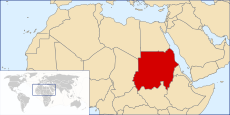United Nations Mission in Sudan
| UNMIS | |
|---|---|
| operation area | Sudan ( South Sudan , Nuba Mountains , Southern Blue Nile and Abyei Area ) |
| German name | United Nations Mission in Sudan |
| English name | United Nations Mission in Sudan |
| French name | Mission des Nations unies au Soudan |
| Based on UN resolution | 1590 (March 24, 2005) |
| Type of mission | Peace mission |
| Beginning | March 2005 |
| The End | July 11, 2011 |
| Deaths | 40 |
| Location of the operational area |

|
The United Nations Mission in Sudan ( English , shortly UNMIS , the United Nations Mission in Sudan ) was a UN mission to secure peace in the African country of Sudan .
On January 9, 2005, the Sudanese government and the Sudanese People's Liberation Army (SPLA) signed the Naivasha Peace Treaty in Kenya , ending the civil war in South Sudan that had been going on since 1983 . On March 24, 2005, the United Nations Security Council resolved to set up a mission (UNMIS) with resolution 1590 , the aim of which was to secure peace in the region of South Sudan . UN Resolution 1590 from 2005 and with it the UN peacekeeping mission has since been extended several times.
UNMIS acted as negotiator for the international community in a role similar to that performed by Operation Lifeline Sudan during the war . The organization consisted of a military and a civilian component. Up to 10,000 soldiers could be stationed in the country, of which a maximum of 750 were military observers. In the civil sector, up to 700 police officers could be deployed throughout the territory of Sudan. A total of soldiers and police officers from 58 nations were deployed there. The main troop contributors with responsibility for sectors were India , Pakistan , Bangladesh , Egypt , Zambia and Kenya , each of whom provided at least one protection battalion and possibly also military camp operations components. In addition, Russia provided military aircraft components for aerial reconnaissance, while China and Cambodia provided support with field camp operations components and logistics.
Since the SPLA was relocated / disarmed in the Kassala area at the end of 2006 and its liquidation by a Nepalese sector has been limited to South Sudan and the controversial areas of Abyei , Nuba Mountains and Southern Blue Nile .
Even Germany took part in the mission. On April 22, 2005, the German Bundestag decided that the Federal Republic would take part in UNMIS with up to 75 unarmed military observers and up to five police officers and staff for the staff. On September 17, 2008 a further participation was decided by the Bundestag. There were always 30-40 members of the Bundeswehr involved in UNMIS, four of them staff officers at the headquarters in Khartoum.
In the independence referendum in South Sudan in 2011 , which was held in accordance with the peace agreement, the voters voted for independence by a large majority. The Sudanese government then announced that it would no longer consent to a further presence of UNMIS on northern Sudanese territory after the independence of South Sudan. The UNMIS mandate was ended on July 11, 2011 with Resolution 1997 of the UN Security Council on July 9, 2011, the day of the South's declaration of independence. In May, UNMIS began withdrawing personnel and resources from the north.
At the request of the government of the independent South Sudan, the UN Security Council decided on the successor mission UNMISS by resolution of the UN Security Council in 1996 .
In addition to UNMIS, the African Union / United Nations Hybrid Operation continued to exist in Darfur in the West Sudanese region of Darfur .
Individual evidence
- ↑ constantly updated deployment figures of the Bundeswehr
- ^ Sudan asks UNMIS to prepare for departure from North , in: Sudan Tribune, May 17, 2011
Web links
- Resolution on the deployment of UNMIS (PDF; 52 kB)
- more information (english)

